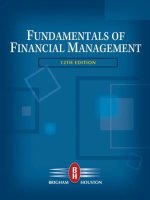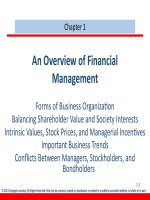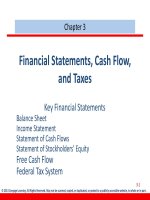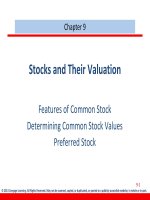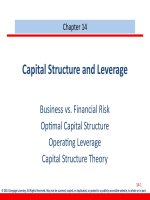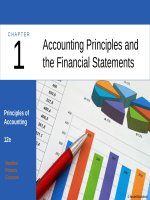Fundamental of financial management 13th ed brigham houston chapter 014
Bạn đang xem bản rút gọn của tài liệu. Xem và tải ngay bản đầy đủ của tài liệu tại đây (135 KB, 43 trang )
Chapter 14
Capital Structure and Leverage
Business vs. Financial Risk
Optimal Capital Structure
Operating Leverage
Capital Structure Theory
14-1
© 2013 Cengage Learning. All Rights Reserved. May not be scanned, copied, or duplicated, or posted to a publicly accessible website, in whole or in part.
What is business risk?
•
The riskiness inherent in the firm’s operations if it
uses no debt.
Probability
Low risk
High risk
0
•
E(ROIC)
EBIT
A commonly used measure of business risk is σROIC.
14-2
© 2013 Cengage Learning. All Rights Reserved. May not be scanned, copied, or duplicated, or posted to a publicly accessible website, in whole or in part.
What determines business risk?
•
•
•
•
•
•
•
•
Competition
Uncertainty about demand (sales)
Uncertainty about output prices
Uncertainty about costs
Product obsolescence
Foreign risk exposure
Regulatory risk and legal exposure
Operating leverage
14-3
© 2013 Cengage Learning. All Rights Reserved. May not be scanned, copied, or duplicated, or posted to a publicly accessible website, in whole or in part.
What is operating leverage, and how does it affect a
firm’s business risk?
•
Operating leverage is the use of fixed costs rather
than variable costs.
•
If most costs are fixed, hence do not decline when
demand falls, then the firm has high operating
leverage.
14-4
© 2013 Cengage Learning. All Rights Reserved. May not be scanned, copied, or duplicated, or posted to a publicly accessible website, in whole or in part.
Effect of Operating Leverage
•
More operating leverage leads to more business risk,
for then a small sales decline causes a big profit
decline.
Rev.
$
Rev.
$
TC
} Profit
TC
FC
FC
QBE
•
Sales
QBE
Sales
What happens if variable costs change?
14-5
© 2013 Cengage Learning. All Rights Reserved. May not be scanned, copied, or duplicated, or posted to a publicly accessible website, in whole or in part.
Using Operating Leverage
•
Typical situation: Can use operating leverage to get
higher ROIC, but risk also increases.
Probability
Low operating leverage
High operating leverage
ROICL
ROICH
14-6
© 2013 Cengage Learning. All Rights Reserved. May not be scanned, copied, or duplicated, or posted to a publicly accessible website, in whole or in part.
Return on Invested Capital (ROIC)
•
ROIC measures the after-tax return that the
company provides for all its investors.
•
ROIC doesn’t vary with changes in capital structure.
EBIT(1 − T)
Investor -supplied capital
($400,000)(0.6)
=
$2,000,000
= 12%
ROIC =
14-7
© 2013 Cengage Learning. All Rights Reserved. May not be scanned, copied, or duplicated, or posted to a publicly accessible website, in whole or in part.
What is financial leverage?
Financial risk?
•
Financial leverage is the use of debt and preferred
stock.
•
Financial risk is the additional risk concentrated on
common stockholders as a result of financial
leverage.
14-8
© 2013 Cengage Learning. All Rights Reserved. May not be scanned, copied, or duplicated, or posted to a publicly accessible website, in whole or in part.
Business Risk vs. Financial Risk
•
Business risk depends on business factors such as
competition, product obsolescence, and operating
leverage.
•
Financial risk depends only on the types of
securities issued.
– More debt, more financial risk.
– Concentrates business risk on stockholders.
14-9
© 2013 Cengage Learning. All Rights Reserved. May not be scanned, copied, or duplicated, or posted to a publicly accessible website, in whole or in part.
An Example:
Illustrating Effects of Financial Leverage
•
Two firms with the same operating leverage, business risk, and
probability distribution of EBIT.
•
Only differ with respect to their use of debt (capital structure).
Firm U
No debt
$20,000 invested capital
40% tax rate
Firm L
$10,000 of 12% debt
$20,000 invested capital
40% tax rate
14-10
© 2013 Cengage Learning. All Rights Reserved. May not be scanned, copied, or duplicated, or posted to a publicly accessible website, in whole or in part.
Firm U: Unleveraged
Probability
EBIT
Interest
EBT
Taxes (40 %)
NI
Bad
0.25
Economy
Average
0.50
Good
0.25
$2,000
0
$2,000
800
$1,200
$3,000
0
$3,000
1,200
$1,800
$4,000
0
$4,000
1,600
$2,400
14-11
© 2013 Cengage Learning. All Rights Reserved. May not be scanned, copied, or duplicated, or posted to a publicly accessible website, in whole or in part.
Firm L: Leveraged
Probability*
Bad
0.25
Economy
Average
0.50
Good
0.25
EBIT *
Interest
EBT
Taxes (40%)
NI
$2,000
1,200
$ 800
320
$ 480
$3,000
1,200
$1,800
720
$1,080
$4,000
1,200
$2,800
1,120
$1,680
*Same as for Firm U.
14-12
© 2013 Cengage Learning. All Rights Reserved. May not be scanned, copied, or duplicated, or posted to a publicly accessible website, in whole or in part.
Ratio Comparison Between Leveraged and
Unleveraged Firms
Firm U
ROIC
ROE
TIE
Bad
6.0%
6.0
∞
Average
9.0%
9.0
∞
Good
12.0%
12.0
∞
Firm L
ROIC
ROE
TIE
Bad
6.0%
4.8
1.7x
Average
9.0%
10.8
2.5x
Good
12.0%
16.8
3.3x
14-13
© 2013 Cengage Learning. All Rights Reserved. May not be scanned, copied, or duplicated, or posted to a publicly accessible website, in whole or in part.
Risk and Return for Leveraged and Unleveraged
Firms
Expected values:
E(ROIC)
E(ROE)
E(TIE)
Firm U
9.0%
9.0 %
∞
Firm L
9.0%
10.8 %
2.5×
Firm U
2.12%
2.12%
0
Firm L
2.12%
4.24%
0.6×
Risk measures:
σ
ROIC
σ
ROE
σ
TIE
14-14
© 2013 Cengage Learning. All Rights Reserved. May not be scanned, copied, or duplicated, or posted to a publicly accessible website, in whole or in part.
The Effect of Leverage on Profitability and Debt
Coverage
•
For leverage to raise expected ROE, must have ROIC
> rd(1 – T).
•
Why? If rd(1 – T) > ROIC, then after-tax interest
expense will be higher than the after-tax operating
income produced by debt-financed assets, so
leverage will depress income.
•
As debt increases, TIE decreases because EBIT is
unaffected by debt, but interest expense increases
(Int Exp = rdD).
14-15
© 2013 Cengage Learning. All Rights Reserved. May not be scanned, copied, or duplicated, or posted to a publicly accessible website, in whole or in part.
Conclusions
•
Return on invested capital (ROIC) is unaffected by
financial leverage.
•
•
L has higher expected ROE because ROIC > rd(1 – T).
L has much wider ROE (and EPS) swings because of
fixed interest charges. Its higher expected return is
accompanied by higher risk.
14-16
© 2013 Cengage Learning. All Rights Reserved. May not be scanned, copied, or duplicated, or posted to a publicly accessible website, in whole or in part.
Optimal Capital Structure
•
The capital structure (mix of debt, preferred, and
common equity) at which P0 is maximized.
•
Trades off higher E(ROE) and EPS against higher risk.
The tax-related benefits of leverage are exactly
offset by the debt’s risk-related costs.
•
The target capital structure is the mix of debt,
preferred stock, and common equity with which the
firm intends to raise capital.
14-17
© 2013 Cengage Learning. All Rights Reserved. May not be scanned, copied, or duplicated, or posted to a publicly accessible website, in whole or in part.
Why do the bond rating and cost of debt depend
upon the amount of debt borrowed?
•
As the firm borrows more money, the firm increases
its financial risk causing the firm’s bond rating to
decrease, and its cost of debt to increase.
14-18
© 2013 Cengage Learning. All Rights Reserved. May not be scanned, copied, or duplicated, or posted to a publicly accessible website, in whole or in part.
Sequence of Events in a Recapitalization
•
•
•
Firm announces the recapitalization.
New debt is issued.
Proceeds are used to repurchase stock.
– The number of shares repurchased is equal to the
amount of debt issued divided by price per share.
14-19
© 2013 Cengage Learning. All Rights Reserved. May not be scanned, copied, or duplicated, or posted to a publicly accessible website, in whole or in part.
Cost of Debt at Different Debt Ratios
Amount
Borrowed
D/Cap.
Ratio
D/E
Ratio
Bond
Rating
rd
0
0
--
--
250
0.125
0.143
AA
8.0%
500
0.250
0.333
A
9.0%
750
0.375
0.600
BBB
11.5%
1,000
0.500
1.000
BB
14.0%
$
0
14-20
© 2013 Cengage Learning. All Rights Reserved. May not be scanned, copied, or duplicated, or posted to a publicly accessible website, in whole or in part.
Analyze the Recapitalization at Various Debt Levels
and Determine the EPS and TIE at Each Level
D = $0
(EBIT − rdD)(1 − T)
EPS =
Shares outstandin g
($400,000)(0.6)
=
80,000
= $3.00
14-21
© 2013 Cengage Learning. All Rights Reserved. May not be scanned, copied, or duplicated, or posted to a publicly accessible website, in whole or in part.
Determining EPS and TIE at Different Levels of
Debt (D = $250,000 and rd = 8%)
$250,000
Shares repurchase d =
= 10,000
$25
(EBIT − rdD)(1 − T)
EPS =
Shares outstandin g
[$400,000 − (0.08)($250,000)](0.6)
=
80,000 − 10,000
= $3.26
EBIT
$400,000
TIE =
=
= 20x
Int. Exp. $20,000
14-22
© 2013 Cengage Learning. All Rights Reserved. May not be scanned, copied, or duplicated, or posted to a publicly accessible website, in whole or in part.
Determining EPS and TIE at Different Levels of
Debt (D = $500,000 and rd = 9%)
$500,000
Shares repurchase d =
= 20,000
$25
(EBIT − rdD)(1 − T)
EPS =
Shares outstandin g
[$400,000 − (0.09)($500,000)](0.6)
=
80,000 − 20,000
= $3.55
EBIT
$400,000
TIE =
=
= 8.9x
Int. Exp. $45,000
14-23
© 2013 Cengage Learning. All Rights Reserved. May not be scanned, copied, or duplicated, or posted to a publicly accessible website, in whole or in part.
Determining EPS and TIE at Different Levels of
Debt (D = $750,000 and rd = 11.5%)
$750,000
Shares repurchase d =
= 30,000
$25
(EBIT − rdD)(1 − T)
EPS =
Shares outstandin g
[$400,000 − (0.115)($750,000)](0.6)
=
80,000 − 30,000
= $3.77
EBIT
$400,000
TIE =
=
= 4.6x
Int. Exp. $86,250
14-24
© 2013 Cengage Learning. All Rights Reserved. May not be scanned, copied, or duplicated, or posted to a publicly accessible website, in whole or in part.
Determining EPS and TIE at Different Levels of
Debt (D = $1,000,000 and rd = 14%)
$1,000,000
Shares repurchase d =
= 40,000
$25
(EBIT − rdD)(1 − T)
EPS =
Shares outstandin g
[$400,000 − (0.14)($1,000,000)](0.6)
=
80,000 − 40,000
= $3.90
EBIT
$400,000
TIE =
=
= 2.9x
Int. Exp. $140,000
14-25
© 2013 Cengage Learning. All Rights Reserved. May not be scanned, copied, or duplicated, or posted to a publicly accessible website, in whole or in part.

